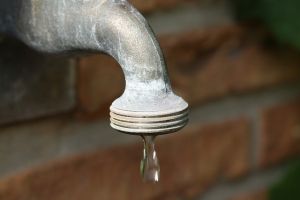

Photo by Maarten Van Damme is licensed under CC BY 2.0
Throughout the U.S., cities, counties and water districts are grappling with an overwhelming issue – leaky pipes that are responsible for massive water losses. It’s a huge problem, and one that is not easily solved.
The nation’s water infrastructure is so old that in many regions, pipelines and distribution systems have simply reached the end of projected life cycles. Some water systems were installed a hundred years ago. In Houston, for example, more than 40 percent of the pipelines are past their 50-year life expectancy.
The water lost may trickle out one drip at a time or, in some situations, pipes break and hemorrhage water for hours before the break can be found. All in all, it is a costly situation and every stakeholder group suffers – taxpayers, industries and public entities. The problem is exacerbated because of extreme drought, increased demand for water resources and the fact that there simply is not adequate public funding available to replace the pipelines.
Tyler lost 2 billion gallons of water in 2014. McKinney lost 2.5 billion gallons. Austin saw almost 5 billion gallons of drinking water escape from its pipes in 2014. But, that is almost a trifle when compared to Houston, which loses more than 22 billion gallons every year. Nationwide, researchers suggest, more than 2 trillion gallons of water are lost annually from leaky pipes and aging infrastructure.
What can be done? What are public officials expected to do without adequate funding? Austin, for example, began an effort to repair and replace inadequate transmission lines in 2012. But, at the pace of work the city can afford, officials say it may take more than 100 years to get the job completed.
New technology can help. Sensors can be placed in pipelines to communicate and alert water authorities immediately when a leak develops. These sensors have the ability to save millions of gallons of wasted water, but they, too, are somewhat costly. In the near future, new smart meters will be installed at businesses and in homes, and these will offer more accurate readings. Still costly, however, and while all technology solutions are expensive, the cost is much less than the loss of scarce water resources.
A 2013 survey of more than 3,000 public water systems across the United States by the Environmental Protection Agency (EPA) showed that $384 billion in improvements will be required to ensure the nation has a sufficient amount of safe drinking water through 2030. That assessment included almost $250 billion to replace or repair aging and deteriorating transmission and distribution lines.
In Texas, the state and its voters took what industry experts say is a great first step in funding solutions for water resources. The passage of the State Water Implementation Fund for Texas (SWIFT) is good … but, it will only be the tip of the iceberg when compared to what is ultimately needed. The Texas State Water Plan estimates the state will need $53 billion worth of water infrastructure projects by 2060. Municipalities will be required to provide about $27 billion of that amount.
The second round of SWIFT applications is due to the Texas Water Development Board very soon. Funding will be parceled out for some large infrastructure projects and there will likely be funding also for pipeline repair. But, in the long term, public-private partnerships will likely be the ultimate solution to solving the state’s water issues.
To stay up to date on the state’s water needs and its plans to meet them, contact Strategic Partnerships and its team of procurement experts.
